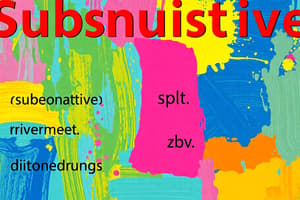Podcast
Questions and Answers
The subjunctive mood is associated with certainty and known conditions.
The subjunctive mood is associated with certainty and known conditions.
False (B)
The imperative mood is often used to express desires or wishes.
The imperative mood is often used to express desires or wishes.
False (B)
The subjunctive mood can be introduced by words such as 'if,' 'wish,' or 'demand.'
The subjunctive mood can be introduced by words such as 'if,' 'wish,' or 'demand.'
True (A)
The imperative mood requires a subject in the sentence.
The imperative mood requires a subject in the sentence.
In the sentence 'If I were you, I would study more,' the speaker is expressing a hypothetical situation.
In the sentence 'If I were you, I would study more,' the speaker is expressing a hypothetical situation.
The sentence 'You are requested to submit a report' uses the imperative mood.
The sentence 'You are requested to submit a report' uses the imperative mood.
The imperative mood can be used to convey requests or demands.
The imperative mood can be used to convey requests or demands.
The subjunctive mood is more commonly used than the imperative mood for straightforward commands.
The subjunctive mood is more commonly used than the imperative mood for straightforward commands.
Both the subjunctive mood and the imperative mood can be used to express uncertainty.
Both the subjunctive mood and the imperative mood can be used to express uncertainty.
Flashcards are hidden until you start studying
Study Notes
Verb moods are categorizations of verb usage that help convey different shades of meaning. The two main verb moods discussed in this article are the subjunctive mood and the imperative mood. These moods serve unique purposes and can coexist within a single sentence, though they generally indicate different levels of certainty or expectation.
Subjunctive Mood
The subjunctive mood is traditionally associated with uncertainty or unlikely conditions. This mood is used to express hypothetical or counterfactual situations where the outcome is not yet known. It is often introduced by words such as "if," "wish," or "demand." Example sentences demonstrating the subjunctive mood include:
- "If I were you, I would study more."
- "I wish I were taller."
- "You are requested to submit a report."
In the first sentence, the speaker wishes they had done something differently in the past, which leads to the hypothetical outcome. In the second sentence, the speaker expresses their desire for a change in their physical attributes. The last sentence illustrates a formal request using the subjunctive mood.
Imperative Mood
On the other hand, the imperative mood is typically used to issue commands or instructions. Unlike the subjunctive mood, the imperative mood requires no subject and directly establishes a directive. Examples of the imperative mood include:
- "Sit down!"
- "Turn off the lights."
- "Close the book."
These sentences instruct someone to perform a specific action, providing clear guidance or direction.
Comparison and Usage
One key point of overlap between the two moods is that both can be used to convey commands or demands. As seen in the search results, there is a debate regarding whether the subjunctive mood or the imperative mood should be preferred in certain cases where commands or demands are expressed. However, the general consensus seems to favor the use of the imperative mood for straightforward commands or demands because it is simpler and more direct.
For example, in the search result found on WordReference, Lucy_zs notes that while the subjunctive mood can be used to express commands or demands, the imperative mood is more commonly used for this purpose due to its directness and simplicity. Similarly, Benj Weinberg's article emphasizes that the imperative mood is used to make requests or demands explicitly.
In conclusion, while both subjunctive and imperative moods can technically be used to convey commands or demands, the imperative mood is typically favored due to its clear and concise nature. The subjunctive mood, on the other hand, is best suited for uncertain, counterfactual, or hypothetical scenarios.
Studying That Suits You
Use AI to generate personalized quizzes and flashcards to suit your learning preferences.




